Cheese Analogue Market
Cheese Analogue Market Size and Share Forecast Outlook 2025 to 2035
The cheese analogue market is projected to grow from USD 4.6 billion in 2025 to USD 8.9 billion by 2035, at a CAGR of 6.8%. Plant-protein (Pea/Soy) will dominate with a 54.0% market share, while slices/slice packs will lead the form segment with a 43.0% share.
Cheese Analogue Market Forecast and Outlook 2025 to 2035
The global cheese analogue market is projected to grow from USD 4.6 billion in 2025 to approximately USD 8.9 billion by 2035, recording an absolute increase of USD 4.3 billion over the forecast period. This translates into a total growth of 93.5%, with the market forecast to expand at a CAGR of 6.8% between 2025 and 2035.
The market is expected to grow by nearly 1.9X during the same period, supported by increasing plant-based diet adoption, growing lactose intolerance awareness, and rising consumer preference for dairy-free alternatives driving premium product development across various food service and retail applications.
Quick Stats for Cheese Analogue Market
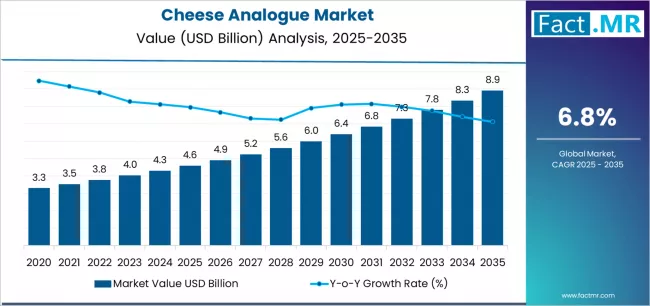
| Cheese Analogue Market Value (2025) | USD 4.6 billion |
|---|---|
| Cheese Analogue Market Forecast Value (2035) | USD 8.9 billion |
| Cheese Analogue Market CAGR | 6.8% |
| Leading Segment by Base (2025) | Plant-protein (Pea/Soy) (54.0%) |
| Leading Segment by Form (2025) | Slices/Slice Packs (43.0%) |
| Leading Segment by Channel (2025) | Retail (68.0%) |
| Key Growth Regions | North America, Europe, and Asia Pacific |
| Top Companies by Market Share | Daiya (Otsuka), Violife (Upfield), Follow Your Heart |
Cheese Analogue Market Key Takeaways
| Metric | Value |
|---|---|
| Market Value (2025) | USD 4.6 billion |
| Market Forecast Value (2035) | USD 8.9 billion |
| Forecast CAGR (2025-2035) | 6.8% |
Why is the Cheese Analogue Market Growing?
| PLANT-BASED DIET TRENDS | HEALTH & DIETARY REQUIREMENTS | INNOVATION & QUALITY STANDARDS |
|---|---|---|
| Global Plant-Based Movement | Lactose Intolerance Solutions | Taste and Texture Innovation |
| Continuous expansion of plant-based diet awareness across established and emerging markets driving demand for dairy-free cheese alternatives. | Modern dietary requirements addressing lactose intolerance and dairy allergies requiring effective cheese substitute solutions with comparable functionality. | Advanced food technology enabling cheese analogues with improved taste, texture, and melting characteristics comparable to traditional dairy cheese. |
| Environmental Consciousness | Health-Conscious Consumption | Clean-Label Standards |
| Growing emphasis on sustainable food choices and environmental impact reduction creating demand for plant-based protein cheese alternatives. | Health-conscious consumers seeking cholesterol-free and lower saturated fat alternatives investing in premium plant-based cheese formulations. | Quality standards requiring natural ingredient formulations and clean-label positioning in plant-based cheese manufacturing. |
| Premium Alternative Positioning | Functional Performance Standards | Nutritional Enhancement Requirements |
| Superior sustainability credentials and ethical considerations making plant-based cheese analogues essential for premium conscious consumer segments. | Food service and retail applications requiring cheese analogues with proven melting, stretching, and flavor characteristics for culinary compatibility. | Diverse nutritional requirements and fortification standards driving need for protein-enhanced and nutritionally optimized cheese alternatives. |
Cheese Analogue Market Segmentation
| Category | Segments Covered |
|---|---|
| By Base | Plant-protein (Pea/Soy), Coconut/Oil-based, Fermentation-derived |
| By Form | Slices/Slice Packs, Shredded, Blocks |
| By Channel | Retail, Foodservice, Industrial |
| By Region | North America, Europe, Asia Pacific, Latin America, Middle East & Africa |
Cheese Analogue Market Analysis by Base
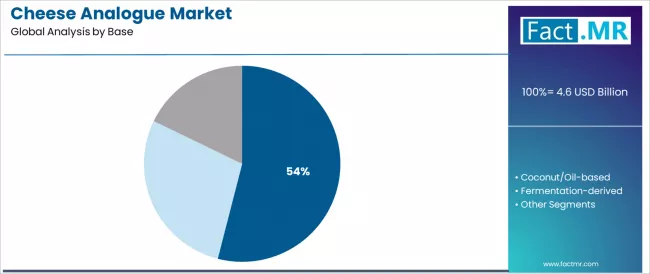
| Segment | 2025 to 2035 Outlook |
|---|---|
| Plant-protein (Pea/Soy) | Leader in 2025 with 54.0% market share; likely to maintain leadership through 2035. Established protein functionality with growing nutritional benefits and versatile application compatibility. Momentum: steady-to-strong. Watchouts: allergen concerns with soy-based formulations, taste challenges requiring continuous improvement and consumer acceptance optimization. |
| Coconut/Oil-based | Strong segment with 28.0% market share due to creamy texture advantages and natural fat content providing authentic mouthfeel characteristics. Benefits from clean-label positioning and tropical ingredient appeal. Momentum: strong growth driven by texture innovation and premium positioning in gourmet applications. |
| Fermentation-derived | Represents 18.0% market share, benefiting from authentic cheese-like flavor development and advanced biotechnology applications. Strong in premium segments requiring sophisticated taste profiles and traditional cheese characteristics. Momentum: rising in innovation-led applications. Watchouts: higher production costs, complex manufacturing processes, scalability challenges for mass market penetration. |
Cheese Analogue Market Analysis by Form
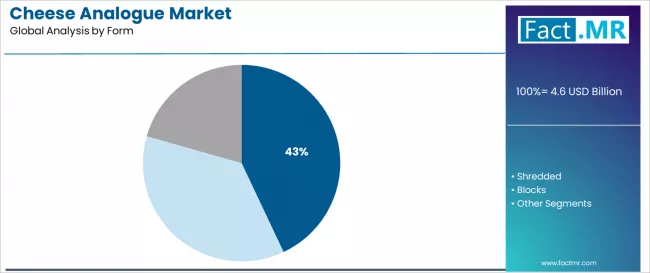
| Segment | 2025 to 2035 Outlook |
|---|---|
| Slices/Slice Packs | At 43.0%, largest form segment in 2025 with established convenience positioning and widespread consumer familiarity. Mature packaging systems, standardized portion control. Momentum: steady growth driven by convenience trends and sandwich application dominance. Watchouts: competition from block formats offering better value, packaging sustainability concerns affecting consumer preferences. |
| Shredded | Strong segment with 34.0% share driven by cooking application versatility and food service adoption. Benefits from pizza and Mexican cuisine integration requiring melting functionality. Momentum: strong growth through 2030, supported by food service expansion and home cooking trends. Watchouts: texture degradation during storage, packaging complexity for maintaining product freshness and appearance. |
| Blocks | Holds 23.0% share encompassing premium positioning and artisanal cheese replacement applications. Growing emphasis on gourmet cooking and cheese board applications driving specialized block formulations. Momentum: moderate growth via premium positioning and specialty culinary applications. Watchouts: slicing convenience barriers, storage and handling complexity compared to pre-processed formats. |
Cheese Analogue Market Analysis by Channel
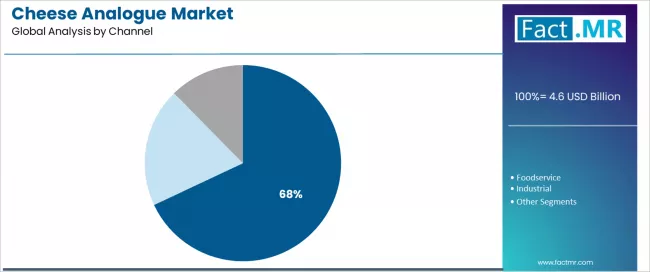
| Segment | 2025 to 2035 Outlook |
|---|---|
| Retail | Dominant segment with 68.0% market share due to consumer direct purchase preferences and widespread grocery availability. Benefits from private label development and promotional pricing strategies. Momentum: steady growth driven by retail expansion and consumer trial facilitation. Watchouts: shelf space competition with traditional dairy cheese, price sensitivity in mainstream retail segments. |
| Foodservice | Represents 22.0% market share, favored for restaurant and food service integration requiring functional cooking performance. Strong in pizza chains and quick-service restaurants adopting plant-based menu options. Momentum: rising growth in food service applications and menu diversification trends. Watchouts: chef training requirements, consistency challenges across different cooking applications and preparation methods. |
| Industrial | Holds 10.0% share encompassing food manufacturing applications and ingredient integration. Growing emphasis on processed food reformulation and plant-based product development driving specialized industrial formulations. Momentum: selective growth in processed food applications and private label manufacturing. Innovation-dependent with longer validation cycles and technical specification requirements. |
DRIVERS
| DRIVERS | RESTRAINTS | KEY TRENDS |
|---|---|---|
| Global Plant-Based Growth | Taste and Texture Challenges | Advanced Fermentation Technologies |
| Continuing expansion of plant-based diet adoption across established and emerging markets driving demand for dairy-free cheese alternatives. | Taste and texture limitations compared to traditional dairy cheese affecting consumer acceptance and repeat purchase behavior. | Integration of advanced fermentation systems, protein optimization, and flavor enhancement technologies enabling superior sensory performance. |
| Health and Wellness Focus | Price Premium Barriers | Sustainable Ingredient Sourcing |
| Increasing recognition of health benefits and dietary restriction solutions supporting lactose-free and cholesterol-free cheese alternatives. | Higher production costs and retail pricing compared to conventional cheese affecting mass market adoption in price-sensitive segments. | Enhanced sustainability credentials, regenerative agriculture integration, and carbon footprint reduction compared to traditional dairy production. |
| Premium Innovation Positioning | Regulatory and Labeling Issues | Nutritional Fortification Development |
| Growing demand for innovative cheese alternatives that support both ethical consumption and culinary performance in premium food applications. | Complex regulatory requirements for dairy alternative labeling and nutritional claims affecting marketing positioning and consumer communication. | Development of protein-enhanced formulations and nutritional optimization providing improved health benefits and functional nutrition positioning. |
Analysis of Cheese Analogue Market by Key Countries
| Country | CAGR (2025-2035) |
|---|---|
| USA | 7.2% |
| Mexico | 6.9% |
| Germany | 6.4% |
| France | 6.3% |
| UK | 6.1% |
| South Korea | 6.0% |
| Japan | 5.8% |
USA Leads Global Market Growth with Plant-Based Innovation Excellence
The cheese analogues market in the USA is projected to exhibit strong growth with a market value of USD 3.2 billion by 2035, driven by expanding plant-based food industry infrastructure and comprehensive dairy-free innovation creating substantial opportunities for alternative cheese suppliers across retail operations, food service applications, and premium wellness sectors.
The country's established alternative protein tradition and expanding vegan market awareness are creating significant demand for both conventional and premium-grade plant-based cheese alternatives.
Major food companies and alternative protein manufacturers including Daiya, Follow Your Heart, and specialty plant-based focused brands are establishing comprehensive local production facilities to support large-scale manufacturing operations and meet growing demand for dairy-free cheese solutions.
- Plant-based food industry modernization programs are supporting widespread adoption of cheese analogues across manufacturing operations, driving demand for high-quality dairy-free cheese alternatives
- Vegan market expansion initiatives and health consciousness development are creating substantial opportunities for cheese suppliers requiring reliable taste performance and cost-effective plant-based solutions
- Food service growth and retail expansion development are facilitating adoption of specialty cheese alternatives throughout major consumer food regions
Mexico Demonstrates Strong Market Potential with Growing Health Awareness
The cheese analogues market in Mexico is expanding to reach USD 1.8 billion by 2035, supported by extensive health awareness expansion and comprehensive food industry development creating sustained demand for reliable cheese alternative solutions across diverse wellness categories and emerging health-conscious segments.
The country's growing middle-class dietary diversity and expanding lactose intolerance awareness are driving demand for cheese alternatives that provide consistent taste performance while supporting cost-effective dietary requirements. Cheese alternative processors and food suppliers are investing in local quality facilities to support growing manufacturing operations and consumer health demand.
- Health awareness operations expansion and food industry capability development are creating opportunities for cheese alternatives across diverse dietary segments requiring reliable performance and competitive accessibility costs
- Lactose intolerance awareness and dietary modernization are driving investments in alternative cheese supply chains supporting health requirements throughout major consumer regions
- Food industry growth and specialty dietary development programs are enhancing demand for quality-grade cheese alternatives throughout Mexican consumer markets
Germany Maintains Leadership with Alternative Food Innovation
Demand for cheese analogues in Germany is projected to reach USD 1.4 billion by 2035, supported by the country's leadership in alternative food innovation and advanced plant-based technologies requiring sophisticated cheese systems for food processing and sustainable nutrition applications.
German companies are implementing high-quality cheese alternative procurement that supports advanced food technology techniques, operational efficiency, and comprehensive sustainability protocols. The market is characterized by focus on operational excellence, environmental compliance, and adherence to stringent food safety and nutritional performance standards.
- Alternative food innovation industry investments are prioritizing premium cheese technologies that demonstrate superior taste performance and sustainability while meeting German food safety and environmental standards
- Plant-based technology leadership programs and operational excellence initiatives are driving adoption of precision-formulated cheese systems that support advanced food processing requirements and sustainability optimization
- Research and development programs for nutritional enhancement are facilitating adoption of specialized cheese alternative techniques throughout major food technology innovation centers
France Expands Market with Culinary Innovation
The cheese analogues market in France is expected to total to USD 1.2 billion by 2035, advancing at a CAGR of 6.3%. Growth is driven by culinary innovation development programs and increasing gourmet alternative food advancement creating sustained opportunities for cheese suppliers serving both food manufacturing operations and specialty culinary contractors.
An established culinary tradition and expanding plant-based awareness are creating demand for cheese alternatives that support diverse culinary requirements while maintaining gastronomic quality standards. Cheese alternative suppliers and gourmet food distributors are developing procurement strategies to support culinary excellence and regulatory compliance.
- Culinary innovation development programs and gourmet alternative food advancement are facilitating adoption of cheese solutions capable of supporting diverse culinary requirements and competitive gastronomic standards
- Plant-based culinary innovation and food technology development programs are enhancing demand for premium-grade cheese alternatives that support operational efficiency and culinary reliability
- EU sustainability adaptation and specialty ingredient development are creating opportunities for advanced cheese alternative technologies across French culinary manufacturing facilities
UK Demonstrates Strong Market Potential with Plant-Based Food Growth
The cheese analogues market in the UK is likely to progress at a CAGR of 6.1%, supported by extensive plant-based food expansion and comprehensive alternative protein development creating sustained demand for reliable cheese alternative solutions across diverse food manufacturing categories and specialty dietary segments.
The country's established alternative protein tradition and expanding environmental awareness are driving demand for cheese alternatives that provide consistent sustainability performance while supporting cost-effective production requirements. Cheese alternative processors and food suppliers are investing in local sustainable facilities to support growing manufacturing operations and environmental compliance demand.
- Plant-based food operations expansion and alternative protein capability development are creating opportunities for cheese alternatives across diverse food segments requiring reliable performance and competitive sustainability costs
- Food manufacturing modernization and environmental technology advancement are driving investments in cheese alternative supply chains supporting dietary requirements throughout major manufacturing regions
- Post-Brexit sustainability growth and specialty food development programs are enhancing demand for premium-grade cheese alternatives throughout British food production areas
South Korea Focuses on K-Food Innovation Excellence
The demand for cheese analogues in South Korea is projected to reach USD 820 million by 2035, expanding at a CAGR of 6.0%, driven by K-food innovation excellence and specialty alternative protein capabilities supporting advanced food technology and comprehensive sustainable nutrition applications.
The country's established food technology tradition and growing health-conscious market segments are creating demand for high-quality cheese alternative solutions that support operational performance and nutritional standards. Cheese alternative suppliers and food manufacturers are maintaining comprehensive development capabilities to support diverse food technology requirements.
- K-food innovation and specialty alternative protein programs are supporting demand for premium-grade cheese alternatives that meet contemporary quality and nutritional performance standards
- Advanced food technology and sustainable nutrition manufacturing programs are creating opportunities for specialized cheese solutions that provide comprehensive dietary support
- Food export excellence and ingredient quality enhancement programs are facilitating adoption of advanced cheese alternative capabilities throughout major food production regions
Japan Demonstrates Traditional Food Integration Excellence
The Japan cheese analogues market is projected to reach USD 680 million by 2035, expanding at a CAGR of 5.8%, driven by traditional food integration excellence and comprehensive food culture capabilities supporting advanced alternative protein development and cultural dietary applications.
An established food culture tradition and growing health market segments are creating demand for high-quality cheese alternative solutions that support cultural dietary practices and modern nutritional standards. Cheese alternative suppliers and food manufacturers are maintaining comprehensive development capabilities to support diverse traditional food requirements.
- Traditional food integration and food culture programs are supporting demand for culturally-adapted cheese alternatives that meet contemporary quality and traditional dietary standards
- Food culture enhancement and alternative protein manufacturing programs are creating opportunities for specialized cheese solutions that provide comprehensive nutritional support
- Quality excellence and ingredient enhancement programs are facilitating adoption of advanced cheese alternative capabilities throughout major food production regions
Europe Market Split by Country
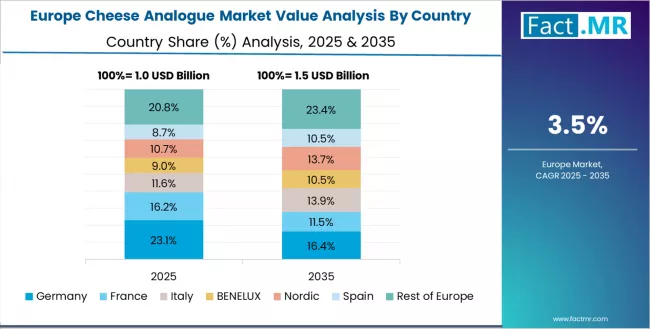
The cheese analogue market in Europe is projected to grow from USD 1.2 billion in 2025 to USD 2.4 billion by 2035, registering a CAGR of 6.3% over the forecast period. Germany is expected to maintain its leadership position with a 28.4% market share in 2025, supported by its advanced alternative food industry and comprehensive plant-based technology capabilities including major facilities for established alternative protein companies and food processing manufacturers.
France follows with a 21.6% share in 2025, projected to reach 21.8% by 2035, driven by comprehensive culinary innovation programs and premium alternative food product development. The UK holds a 18.7% share in 2025, expected to maintain 18.4% by 2035 despite post-Brexit regulatory adjustments.
Italy commands a 15.9% share, while Spain accounts for 9.2% in 2025. The Rest of Europe region is anticipated to gain momentum, expanding its collective share from 6.2% to 6.8% by 2035, attributed to increasing plant-based awareness in Nordic countries and emerging Eastern European food manufacturers implementing alternative protein strategies.
Premium Quality Standards Define Japanese Market Dynamics
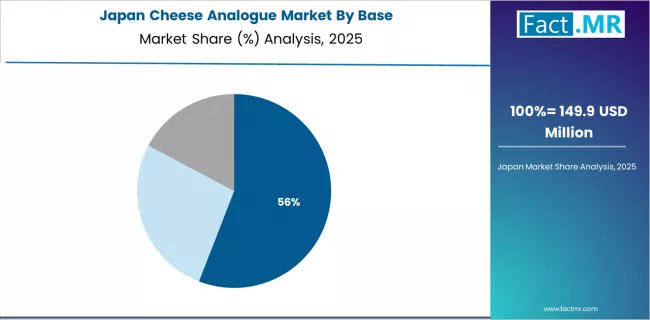
The cheese analogue market in Japan reflects the country's exacting quality standards and sophisticated food culture expectations. Major food and alternative protein companies including Otsuka, Meiji, and Kikkoman maintain rigorous supplier qualification processes that often exceed international standards, requiring extensive documentation, taste testing, and facility audits that can take 12-18 months to complete. This creates high barriers for new suppliers but ensures consistent quality that supports premium product positioning.
The Japanese market demonstrates unique taste preferences, with significant demand for subtle flavor profiles tailored to Japanese food culture including miso integration, traditional cooking applications, and cultural taste preferences. Companies require specific umami characteristics and texture compatibility that differ from Western applications, driving demand for specialized formulation and cultural adaptation capabilities.
Regulatory oversight through the Ministry of Health, Labour and Welfare emphasizes comprehensive food safety standards and nutritional requirements that surpass most international benchmarks. The alternative protein registration system requires detailed nutritional documentation, creating advantages for suppliers with transparent research data and comprehensive nutritional validation.
Supply chain management focuses on relationship-based partnerships rather than purely transactional procurement. Japanese companies typically maintain long-term supplier relationships spanning decades, with annual contract negotiations emphasizing taste consistency and cultural compatibility over price competition. This stability supports investment in specialized production equipment tailored to Japanese food specifications.
Market Dynamics Drive Innovation in South Korea
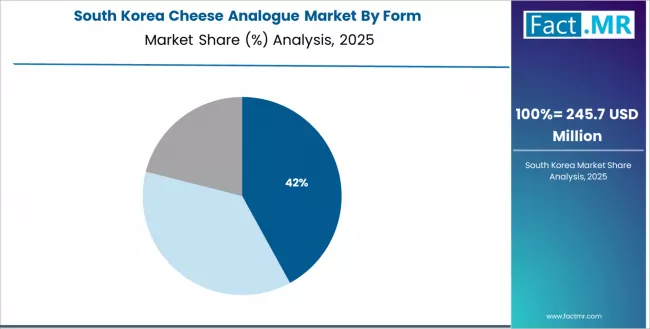
South Korean cheese analogue operations reflect the country's advanced food technology industry and export-oriented business model. Major food and alternative protein conglomerates including CJ CheilJedang, Lotte, and food-focused companies drive sophisticated ingredient procurement strategies, establishing direct relationships with global suppliers to secure consistent quality and pricing for their alternative protein and food processing operations targeting both domestic and international markets.
The market demonstrates particular strength in applying cheese analogues to K-food applications, with companies developing innovative formulations that integrate traditional Korean cooking methods with modern alternative protein science and culinary approaches. This innovation approach creates demand for specific cheese specifications that often exceed standard applications, requiring suppliers to adapt formulation and processing techniques.
Regulatory frameworks emphasize food safety and export competitiveness, with Korean Food and Drug Administration standards often exceeding international requirements. This creates barriers for lower-quality suppliers but benefits established manufacturers who can demonstrate advanced taste and safety capabilities. The regulatory environment particularly favors suppliers with comprehensive documentation and quality management systems.
Supply chain efficiency remains critical given Korea's position as a food export hub. Companies increasingly pursue long-term contracts with suppliers in North America, Europe, and plant protein regions to ensure reliable access to high-quality ingredients while managing seasonal availability and foreign exchange risks. Advanced processing and logistics investments support product quality preservation during production and distribution cycles.
Competitive Landscape of Cheese Analogue Market
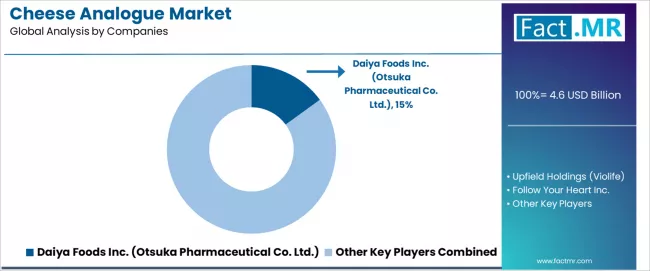
Profit pools are consolidating upstream in scaled plant protein processing systems and downstream in value-added specialty formulations for retail, food service, and industrial applications. Value is migrating from basic cheese alternative manufacturing to specification-tight, taste-validated cheese solutions where melting performance, nutritional content, and authentic flavor profiles command premiums.
Several archetypes set the pace: global alternative protein companies defending share through brand recognition and distribution scale; specialty cheese alternative manufacturers that manage formulation complexity and taste optimization; premium artisanal producers with culinary IP and gourmet positioning; and innovation-focused companies pulling volume in fermentation-derived and next-generation protein applications.
Switching costs—recipe development, taste acceptance, supply chain integration—stabilize market position for incumbents, while taste improvement breakthroughs (fermentation technology, protein innovation, texture advancement) and plant-based trends reopen opportunities for superior formulations. Consolidation and vertical integration continue; retail procurement dominates consumer channels as food service applications remain performance dependent. Market dynamics favor suppliers with comprehensive taste development capabilities, culinary expertise, and established food industry relationships.
The competitive environment presents both opportunities and constraints. Premium taste requirements create barriers for basic alternative manufacturers but establish standards that favor innovative formulations over conventional plant-based approaches. Consumer acceptance increasingly influences success as repeat purchase depends on taste satisfaction and culinary performance.
| Stakeholder Type | Primary Advantage | Repeatable Plays |
|---|---|---|
| Global alternative protein companies | Brand recognition, distribution scale | Long-term retail partnerships, consistent quality standards, mass market accessibility |
| Specialty cheese manufacturers | Formulation expertise, taste optimization | Premium positioning, culinary applications, gourmet targeting |
| Premium artisanal producers | Culinary IP and gourmet positioning | Artisanal marketing, specialty retail, chef relationships |
| Innovation-focused companies | Next-generation technology, fermentation IP | Scientific differentiation, technology partnerships, premium pricing |
Key Players in the Cheese Analogue Market
- Daiya Foods Inc. (Otsuka Pharmaceutical Co. Ltd.)
- Upfield Holdings (Violife)
- Follow Your Heart Inc.
- Kraft Foods Group LLC
- Miyoko’s Kitchen Inc.
- Tofutti Brands Inc.
- Good Planet Foods Inc.
- Melt Inc.
- Bute Island Foods Ltd.
- Galaxy Nutritional Foods Inc.
Scope of the Report
| Items | Values |
|---|---|
| Quantitative Units | USD 4.6 Billion |
| Product | Plant-protein (Pea/Soy), Coconut/Oil-based, Fermentation-derived |
| Form | Slices/Slice Packs, Shredded, Blocks |
| Regions Covered | North America, Latin America, Europe, Asia Pacific, Middle East & Africa |
| Country Covered | United States, Germany, France, UK, South Korea, Japan, Mexico, and other 40+ countries |
| Key Companies Profiled | Daiya (Otsuka), Violife (Upfield), Follow Your Heart, Kraft plant lines, Miyoko's, Tofutti, Good Planet, Melt, Bute Island Foods, Galaxy Nutritional Foods |
| Additional Attributes | Dollar sales by base/form/channel, regional demand (NA, EU, APAC), competitive landscape, plant-based adoption, taste innovation integration, and advanced formulation innovations driving taste enhancement, nutritional optimization, and culinary performance |
Cheese Analogue Market Segmentation
-
By Base :
- Plant-protein (Pea/Soy)
- Coconut/Oil-based
- Fermentation-derived
-
By Form :
- Slices/Slice Packs
- Shredded
- Blocks
-
By Channel :
- Retail
- Foodservice
- Industrial
-
By Region :
- North America
- Europe
- Asia Pacific
- Latin America
- Middle East & Africa
Table of Content
- Executive Summary
- Global Market Outlook
- Demand to side Trends
- Supply to side Trends
- Technology Roadmap Analysis
- Analysis and Recommendations
- Market Overview
- Market Coverage / Taxonomy
- Market Definition / Scope / Limitations
- Market Background
- Market Dynamics
- Drivers
- Restraints
- Opportunity
- Trends
- Scenario Forecast
- Demand in Optimistic Scenario
- Demand in Likely Scenario
- Demand in Conservative Scenario
- Opportunity Map Analysis
- Product Life Cycle Analysis
- Supply Chain Analysis
- Investment Feasibility Matrix
- Value Chain Analysis
- PESTLE and Porter’s Analysis
- Regulatory Landscape
- Regional Parent Market Outlook
- Production and Consumption Statistics
- Import and Export Statistics
- Market Dynamics
- Global Market Analysis 2020 to 2024 and Forecast, 2025 to 2035
- Historical Market Size Value (USD Million) Analysis, 2020 to 2024
- Current and Future Market Size Value (USD Million) Projections, 2025 to 2035
- Y to o to Y Growth Trend Analysis
- Absolute $ Opportunity Analysis
- Global Market Pricing Analysis 2020 to 2024 and Forecast 2025 to 2035
- Global Market Analysis 2020 to 2024 and Forecast 2025 to 2035, By Base
- Introduction / Key Findings
- Historical Market Size Value (USD Million) Analysis By Base , 2020 to 2024
- Current and Future Market Size Value (USD Million) Analysis and Forecast By Base , 2025 to 2035
- Plant-protein (Pea/Soy)
- Coconut/Oil-based
- Fermentation-derived
- Y to o to Y Growth Trend Analysis By Base , 2020 to 2024
- Absolute $ Opportunity Analysis By Base , 2025 to 2035
- Global Market Analysis 2020 to 2024 and Forecast 2025 to 2035, By Form
- Introduction / Key Findings
- Historical Market Size Value (USD Million) Analysis By Form, 2020 to 2024
- Current and Future Market Size Value (USD Million) Analysis and Forecast By Form, 2025 to 2035
- Slices/Slice Packs
- Shredded
- Blocks
- Y to o to Y Growth Trend Analysis By Form, 2020 to 2024
- Absolute $ Opportunity Analysis By Form, 2025 to 2035
- Global Market Analysis 2020 to 2024 and Forecast 2025 to 2035, By Channel
- Introduction / Key Findings
- Historical Market Size Value (USD Million) Analysis By Channel, 2020 to 2024
- Current and Future Market Size Value (USD Million) Analysis and Forecast By Channel, 2025 to 2035
- Retail
- Foodservice
- Industrial
- Y to o to Y Growth Trend Analysis By Channel, 2020 to 2024
- Absolute $ Opportunity Analysis By Channel, 2025 to 2035
- Global Market Analysis 2020 to 2024 and Forecast 2025 to 2035, By Region
- Introduction
- Historical Market Size Value (USD Million) Analysis By Region, 2020 to 2024
- Current Market Size Value (USD Million) Analysis and Forecast By Region, 2025 to 2035
- North America
- Latin America
- Western Europe
- Eastern Europe
- East Asia
- South Asia and Pacific
- Middle East & Africa
- Market Attractiveness Analysis By Region
- North America Market Analysis 2020 to 2024 and Forecast 2025 to 2035, By Country
- Historical Market Size Value (USD Million) Trend Analysis By Market Taxonomy, 2020 to 2024
- Market Size Value (USD Million) Forecast By Market Taxonomy, 2025 to 2035
- By Country
- USA
- Canada
- Mexico
- By Base
- By Form
- By Channel
- By Country
- Market Attractiveness Analysis
- By Country
- By Base
- By Form
- By Channel
- Key Takeaways
- Latin America Market Analysis 2020 to 2024 and Forecast 2025 to 2035, By Country
- Historical Market Size Value (USD Million) Trend Analysis By Market Taxonomy, 2020 to 2024
- Market Size Value (USD Million) Forecast By Market Taxonomy, 2025 to 2035
- By Country
- Brazil
- Chile
- Rest of Latin America
- By Base
- By Form
- By Channel
- By Country
- Market Attractiveness Analysis
- By Country
- By Base
- By Form
- By Channel
- Key Takeaways
- Western Europe Market Analysis 2020 to 2024 and Forecast 2025 to 2035, By Country
- Historical Market Size Value (USD Million) Trend Analysis By Market Taxonomy, 2020 to 2024
- Market Size Value (USD Million) Forecast By Market Taxonomy, 2025 to 2035
- By Country
- Germany
- UK
- Italy
- Spain
- France
- Nordic
- BENELUX
- Rest of Western Europe
- By Base
- By Form
- By Channel
- By Country
- Market Attractiveness Analysis
- By Country
- By Base
- By Form
- By Channel
- Key Takeaways
- Eastern Europe Market Analysis 2020 to 2024 and Forecast 2025 to 2035, By Country
- Historical Market Size Value (USD Million) Trend Analysis By Market Taxonomy, 2020 to 2024
- Market Size Value (USD Million) Forecast By Market Taxonomy, 2025 to 2035
- By Country
- Russia
- Poland
- Hungary
- Balkan & Baltic
- Rest of Eastern Europe
- By Base
- By Form
- By Channel
- By Country
- Market Attractiveness Analysis
- By Country
- By Base
- By Form
- By Channel
- Key Takeaways
- East Asia Market Analysis 2020 to 2024 and Forecast 2025 to 2035, By Country
- Historical Market Size Value (USD Million) Trend Analysis By Market Taxonomy, 2020 to 2024
- Market Size Value (USD Million) Forecast By Market Taxonomy, 2025 to 2035
- By Country
- China
- Japan
- South Korea
- By Base
- By Form
- By Channel
- By Country
- Market Attractiveness Analysis
- By Country
- By Base
- By Form
- By Channel
- Key Takeaways
- South Asia and Pacific Market Analysis 2020 to 2024 and Forecast 2025 to 2035, By Country
- Historical Market Size Value (USD Million) Trend Analysis By Market Taxonomy, 2020 to 2024
- Market Size Value (USD Million) Forecast By Market Taxonomy, 2025 to 2035
- By Country
- India
- ASEAN
- Australia & New Zealand
- Rest of South Asia and Pacific
- By Base
- By Form
- By Channel
- By Country
- Market Attractiveness Analysis
- By Country
- By Base
- By Form
- By Channel
- Key Takeaways
- Middle East & Africa Market Analysis 2020 to 2024 and Forecast 2025 to 2035, By Country
- Historical Market Size Value (USD Million) Trend Analysis By Market Taxonomy, 2020 to 2024
- Market Size Value (USD Million) Forecast By Market Taxonomy, 2025 to 2035
- By Country
- Kingdom of Saudi Arabia
- Other GCC Countries
- Turkiye
- South Africa
- Other African Union
- Rest of Middle East & Africa
- By Base
- By Form
- By Channel
- By Country
- Market Attractiveness Analysis
- By Country
- By Base
- By Form
- By Channel
- Key Takeaways
- Key Countries Market Analysis
- USA
- Pricing Analysis
- Market Share Analysis, 2024
- By Base
- By Form
- By Channel
- Canada
- Pricing Analysis
- Market Share Analysis, 2024
- By Base
- By Form
- By Channel
- Mexico
- Pricing Analysis
- Market Share Analysis, 2024
- By Base
- By Form
- By Channel
- Brazil
- Pricing Analysis
- Market Share Analysis, 2024
- By Base
- By Form
- By Channel
- Chile
- Pricing Analysis
- Market Share Analysis, 2024
- By Base
- By Form
- By Channel
- Germany
- Pricing Analysis
- Market Share Analysis, 2024
- By Base
- By Form
- By Channel
- UK
- Pricing Analysis
- Market Share Analysis, 2024
- By Base
- By Form
- By Channel
- Italy
- Pricing Analysis
- Market Share Analysis, 2024
- By Base
- By Form
- By Channel
- Spain
- Pricing Analysis
- Market Share Analysis, 2024
- By Base
- By Form
- By Channel
- France
- Pricing Analysis
- Market Share Analysis, 2024
- By Base
- By Form
- By Channel
- India
- Pricing Analysis
- Market Share Analysis, 2024
- By Base
- By Form
- By Channel
- ASEAN
- Pricing Analysis
- Market Share Analysis, 2024
- By Base
- By Form
- By Channel
- Australia & New Zealand
- Pricing Analysis
- Market Share Analysis, 2024
- By Base
- By Form
- By Channel
- China
- Pricing Analysis
- Market Share Analysis, 2024
- By Base
- By Form
- By Channel
- Japan
- Pricing Analysis
- Market Share Analysis, 2024
- By Base
- By Form
- By Channel
- South Korea
- Pricing Analysis
- Market Share Analysis, 2024
- By Base
- By Form
- By Channel
- Russia
- Pricing Analysis
- Market Share Analysis, 2024
- By Base
- By Form
- By Channel
- Poland
- Pricing Analysis
- Market Share Analysis, 2024
- By Base
- By Form
- By Channel
- Hungary
- Pricing Analysis
- Market Share Analysis, 2024
- By Base
- By Form
- By Channel
- Kingdom of Saudi Arabia
- Pricing Analysis
- Market Share Analysis, 2024
- By Base
- By Form
- By Channel
- Turkiye
- Pricing Analysis
- Market Share Analysis, 2024
- By Base
- By Form
- By Channel
- South Africa
- Pricing Analysis
- Market Share Analysis, 2024
- By Base
- By Form
- By Channel
- USA
- Market Structure Analysis
- Competition Dashboard
- Competition Benchmarking
- Market Share Analysis of Top Players
- By Regional
- By Base
- By Form
- By Channel
- Competition Analysis
- Competition Deep Dive
- Daiya Foods Inc. (Otsuka Pharmaceutical Co. Ltd.)
- Overview
- Product Portfolio
- Profitability by Market Segments (Product/Age /Sales Channel/Region)
- Sales Footprint
- Strategy Overview
- Marketing Strategy
- Product Strategy
- Channel Strategy
- Upfield Holdings (Violife)
- Follow Your Heart Inc.
- Kraft Foods Group LLC
- Miyoko’s Kitchen Inc.
- Tofutti Brands Inc.
- Good Planet Foods Inc.
- Melt Inc.
- Bute Island Foods Ltd.
- Galaxy Nutritional Foods Inc.
- Daiya Foods Inc. (Otsuka Pharmaceutical Co. Ltd.)
- Competition Deep Dive
- Assumptions & Acronyms Used
- Research Methodology
List Of Table
- Table 1: Global Market Value (USD Million) Forecast by Region, 2020 to 2035
- Table 2: Global Market Value (USD Million) Forecast by Base , 2020 to 2035
- Table 3: Global Market Value (USD Million) Forecast by Form, 2020 to 2035
- Table 4: Global Market Value (USD Million) Forecast by Channel, 2020 to 2035
- Table 5: North America Market Value (USD Million) Forecast by Country, 2020 to 2035
- Table 6: North America Market Value (USD Million) Forecast by Base , 2020 to 2035
- Table 7: North America Market Value (USD Million) Forecast by Form, 2020 to 2035
- Table 8: North America Market Value (USD Million) Forecast by Channel, 2020 to 2035
- Table 9: Latin America Market Value (USD Million) Forecast by Country, 2020 to 2035
- Table 10: Latin America Market Value (USD Million) Forecast by Base , 2020 to 2035
- Table 11: Latin America Market Value (USD Million) Forecast by Form, 2020 to 2035
- Table 12: Latin America Market Value (USD Million) Forecast by Channel, 2020 to 2035
- Table 13: Western Europe Market Value (USD Million) Forecast by Country, 2020 to 2035
- Table 14: Western Europe Market Value (USD Million) Forecast by Base , 2020 to 2035
- Table 15: Western Europe Market Value (USD Million) Forecast by Form, 2020 to 2035
- Table 16: Western Europe Market Value (USD Million) Forecast by Channel, 2020 to 2035
- Table 17: Eastern Europe Market Value (USD Million) Forecast by Country, 2020 to 2035
- Table 18: Eastern Europe Market Value (USD Million) Forecast by Base , 2020 to 2035
- Table 19: Eastern Europe Market Value (USD Million) Forecast by Form, 2020 to 2035
- Table 20: Eastern Europe Market Value (USD Million) Forecast by Channel, 2020 to 2035
- Table 21: East Asia Market Value (USD Million) Forecast by Country, 2020 to 2035
- Table 22: East Asia Market Value (USD Million) Forecast by Base , 2020 to 2035
- Table 23: East Asia Market Value (USD Million) Forecast by Form, 2020 to 2035
- Table 24: East Asia Market Value (USD Million) Forecast by Channel, 2020 to 2035
- Table 25: South Asia and Pacific Market Value (USD Million) Forecast by Country, 2020 to 2035
- Table 26: South Asia and Pacific Market Value (USD Million) Forecast by Base , 2020 to 2035
- Table 27: South Asia and Pacific Market Value (USD Million) Forecast by Form, 2020 to 2035
- Table 28: South Asia and Pacific Market Value (USD Million) Forecast by Channel, 2020 to 2035
- Table 29: Middle East & Africa Market Value (USD Million) Forecast by Country, 2020 to 2035
- Table 30: Middle East & Africa Market Value (USD Million) Forecast by Base , 2020 to 2035
- Table 31: Middle East & Africa Market Value (USD Million) Forecast by Form, 2020 to 2035
- Table 32: Middle East & Africa Market Value (USD Million) Forecast by Channel, 2020 to 2035
List Of Figures
- Figure 1: Global Market Pricing Analysis
- Figure 2: Global Market Value (USD Million) Forecast 2020-2035
- Figure 3: Global Market Value Share and BPS Analysis by Base , 2025 and 2035
- Figure 4: Global Market Y to o to Y Growth Comparison by Base , 2025-2035
- Figure 5: Global Market Attractiveness Analysis by Base
- Figure 6: Global Market Value Share and BPS Analysis by Form, 2025 and 2035
- Figure 7: Global Market Y to o to Y Growth Comparison by Form, 2025-2035
- Figure 8: Global Market Attractiveness Analysis by Form
- Figure 9: Global Market Value Share and BPS Analysis by Channel, 2025 and 2035
- Figure 10: Global Market Y to o to Y Growth Comparison by Channel, 2025-2035
- Figure 11: Global Market Attractiveness Analysis by Channel
- Figure 12: Global Market Value (USD Million) Share and BPS Analysis by Region, 2025 and 2035
- Figure 13: Global Market Y to o to Y Growth Comparison by Region, 2025-2035
- Figure 14: Global Market Attractiveness Analysis by Region
- Figure 15: North America Market Incremental Dollar Opportunity, 2025-2035
- Figure 16: Latin America Market Incremental Dollar Opportunity, 2025-2035
- Figure 17: Western Europe Market Incremental Dollar Opportunity, 2025-2035
- Figure 18: Eastern Europe Market Incremental Dollar Opportunity, 2025-2035
- Figure 19: East Asia Market Incremental Dollar Opportunity, 2025-2035
- Figure 20: South Asia and Pacific Market Incremental Dollar Opportunity, 2025-2035
- Figure 21: Middle East & Africa Market Incremental Dollar Opportunity, 2025-2035
- Figure 22: North America Market Value Share and BPS Analysis by Country, 2025 and 2035
- Figure 23: North America Market Value Share and BPS Analysis by Base , 2025 and 2035
- Figure 24: North America Market Y to o to Y Growth Comparison by Base , 2025-2035
- Figure 25: North America Market Attractiveness Analysis by Base
- Figure 26: North America Market Value Share and BPS Analysis by Form, 2025 and 2035
- Figure 27: North America Market Y to o to Y Growth Comparison by Form, 2025-2035
- Figure 28: North America Market Attractiveness Analysis by Form
- Figure 29: North America Market Value Share and BPS Analysis by Channel, 2025 and 2035
- Figure 30: North America Market Y to o to Y Growth Comparison by Channel, 2025-2035
- Figure 31: North America Market Attractiveness Analysis by Channel
- Figure 32: Latin America Market Value Share and BPS Analysis by Country, 2025 and 2035
- Figure 33: Latin America Market Value Share and BPS Analysis by Base , 2025 and 2035
- Figure 34: Latin America Market Y to o to Y Growth Comparison by Base , 2025-2035
- Figure 35: Latin America Market Attractiveness Analysis by Base
- Figure 36: Latin America Market Value Share and BPS Analysis by Form, 2025 and 2035
- Figure 37: Latin America Market Y to o to Y Growth Comparison by Form, 2025-2035
- Figure 38: Latin America Market Attractiveness Analysis by Form
- Figure 39: Latin America Market Value Share and BPS Analysis by Channel, 2025 and 2035
- Figure 40: Latin America Market Y to o to Y Growth Comparison by Channel, 2025-2035
- Figure 41: Latin America Market Attractiveness Analysis by Channel
- Figure 42: Western Europe Market Value Share and BPS Analysis by Country, 2025 and 2035
- Figure 43: Western Europe Market Value Share and BPS Analysis by Base , 2025 and 2035
- Figure 44: Western Europe Market Y to o to Y Growth Comparison by Base , 2025-2035
- Figure 45: Western Europe Market Attractiveness Analysis by Base
- Figure 46: Western Europe Market Value Share and BPS Analysis by Form, 2025 and 2035
- Figure 47: Western Europe Market Y to o to Y Growth Comparison by Form, 2025-2035
- Figure 48: Western Europe Market Attractiveness Analysis by Form
- Figure 49: Western Europe Market Value Share and BPS Analysis by Channel, 2025 and 2035
- Figure 50: Western Europe Market Y to o to Y Growth Comparison by Channel, 2025-2035
- Figure 51: Western Europe Market Attractiveness Analysis by Channel
- Figure 52: Eastern Europe Market Value Share and BPS Analysis by Country, 2025 and 2035
- Figure 53: Eastern Europe Market Value Share and BPS Analysis by Base , 2025 and 2035
- Figure 54: Eastern Europe Market Y to o to Y Growth Comparison by Base , 2025-2035
- Figure 55: Eastern Europe Market Attractiveness Analysis by Base
- Figure 56: Eastern Europe Market Value Share and BPS Analysis by Form, 2025 and 2035
- Figure 57: Eastern Europe Market Y to o to Y Growth Comparison by Form, 2025-2035
- Figure 58: Eastern Europe Market Attractiveness Analysis by Form
- Figure 59: Eastern Europe Market Value Share and BPS Analysis by Channel, 2025 and 2035
- Figure 60: Eastern Europe Market Y to o to Y Growth Comparison by Channel, 2025-2035
- Figure 61: Eastern Europe Market Attractiveness Analysis by Channel
- Figure 62: East Asia Market Value Share and BPS Analysis by Country, 2025 and 2035
- Figure 63: East Asia Market Value Share and BPS Analysis by Base , 2025 and 2035
- Figure 64: East Asia Market Y to o to Y Growth Comparison by Base , 2025-2035
- Figure 65: East Asia Market Attractiveness Analysis by Base
- Figure 66: East Asia Market Value Share and BPS Analysis by Form, 2025 and 2035
- Figure 67: East Asia Market Y to o to Y Growth Comparison by Form, 2025-2035
- Figure 68: East Asia Market Attractiveness Analysis by Form
- Figure 69: East Asia Market Value Share and BPS Analysis by Channel, 2025 and 2035
- Figure 70: East Asia Market Y to o to Y Growth Comparison by Channel, 2025-2035
- Figure 71: East Asia Market Attractiveness Analysis by Channel
- Figure 72: South Asia and Pacific Market Value Share and BPS Analysis by Country, 2025 and 2035
- Figure 73: South Asia and Pacific Market Value Share and BPS Analysis by Base , 2025 and 2035
- Figure 74: South Asia and Pacific Market Y to o to Y Growth Comparison by Base , 2025-2035
- Figure 75: South Asia and Pacific Market Attractiveness Analysis by Base
- Figure 76: South Asia and Pacific Market Value Share and BPS Analysis by Form, 2025 and 2035
- Figure 77: South Asia and Pacific Market Y to o to Y Growth Comparison by Form, 2025-2035
- Figure 78: South Asia and Pacific Market Attractiveness Analysis by Form
- Figure 79: South Asia and Pacific Market Value Share and BPS Analysis by Channel, 2025 and 2035
- Figure 80: South Asia and Pacific Market Y to o to Y Growth Comparison by Channel, 2025-2035
- Figure 81: South Asia and Pacific Market Attractiveness Analysis by Channel
- Figure 82: Middle East & Africa Market Value Share and BPS Analysis by Country, 2025 and 2035
- Figure 83: Middle East & Africa Market Value Share and BPS Analysis by Base , 2025 and 2035
- Figure 84: Middle East & Africa Market Y to o to Y Growth Comparison by Base , 2025-2035
- Figure 85: Middle East & Africa Market Attractiveness Analysis by Base
- Figure 86: Middle East & Africa Market Value Share and BPS Analysis by Form, 2025 and 2035
- Figure 87: Middle East & Africa Market Y to o to Y Growth Comparison by Form, 2025-2035
- Figure 88: Middle East & Africa Market Attractiveness Analysis by Form
- Figure 89: Middle East & Africa Market Value Share and BPS Analysis by Channel, 2025 and 2035
- Figure 90: Middle East & Africa Market Y to o to Y Growth Comparison by Channel, 2025-2035
- Figure 91: Middle East & Africa Market Attractiveness Analysis by Channel
- Figure 92: Global Market - Tier Structure Analysis
- Figure 93: Global Market - Company Share Analysis
- FAQs -
How big is the cheese analogue market in 2025?
The global cheese analogue market is estimated to be valued at USD 4.6 billion in 2025.
What will be the size of cheese analogue market in 2035?
The market size for the cheese analogue market is projected to reach USD 8.9 billion by 2035.
How much will be the cheese analogue market growth between 2025 and 2035?
The cheese analogue market is expected to grow at a 6.8% CAGR between 2025 and 2035.
What are the key product types in the cheese analogue market?
The key product types in cheese analogue market are plant-protein (pea/soy), coconut/oil-based and fermentation-derived.
Which form segment to contribute significant share in the cheese analogue market in 2025?
In terms of form, slices/slice packs segment to command 43.0% share in the cheese analogue market in 2025.